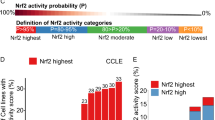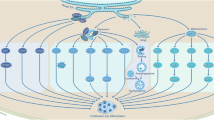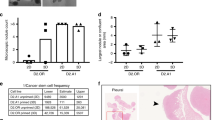Abstract
The aggressiveness of glioblastoma multiforme (GBM) is defined by local invasion and resistance to therapy. Within established GBM, a subpopulation of tumor-initiating cells with stem-like properties (GBM stem cells, GSCs) is believed to underlie resistance to therapy. The metabolic pathway autophagy has been implicated in the regulation of survival in GBM. However, the status of autophagy in GBM and its role in the cancer stem cell fraction is currently unclear. We found that a number of autophagy regulators are highly expressed in GBM tumors carrying a mesenchymal signature, which defines aggressiveness and invasion, and are associated with components of the MAPK pathway. This autophagy signature included the autophagy-associated genes DRAM1 and SQSTM1, which encode a key regulator of selective autophagy, p62. High levels of DRAM1 were associated with shorter overall survival in GBM patients. In GSCs, DRAM1 and SQSTM1 expression correlated with activation of MAPK and expression of the mesenchymal marker c-MET. DRAM1 knockdown decreased p62 localization to autophagosomes and its autophagy-mediated degradation, thus suggesting a role for DRAM1 in p62-mediated autophagy. In contrast, autophagy induced by starvation or inhibition of mTOR/PI-3K was not affected by either DRAM1 or p62 downregulation. Functionally, DRAM1 and p62 regulate cell motility and invasion in GSCs. This was associated with alterations of energy metabolism, in particular reduced ATP and lactate levels. Taken together, these findings shed new light on the role of autophagy in GBM and reveal a novel function of the autophagy regulators DRAM1 and p62 in control of migration/invasion in cancer stem cells.
This is a preview of subscription content, access via your institution
Access options
Subscribe to this journal
Receive 50 print issues and online access
$259.00 per year
only $5.18 per issue
Buy this article
- Purchase on Springer Link
- Instant access to full article PDF
Prices may be subject to local taxes which are calculated during checkout







Similar content being viewed by others
References
Zhou BB, Zhang H, Damelin M, Geles KG, Grindley JC, Dirks PB . Tumour-initiating cells: challenges and opportunities for anticancer drug discovery. Nat Rev Drug Discov 2009; 8: 806–823.
Ricci-Vitiani L, Pallini R, Biffoni M, Todaro M, Invernici G, Cenci T et al. Tumour vascularization via endothelial differentiation of glioblastoma stem-like cells. Nature 2010; 468: 824–828.
Wang R, Chadalavada K, Wilshire J, Kowalik U, Hovinga KE, Geber A et al. Glioblastoma stem-like cells give rise to tumour endothelium. Nature 2010; 468: 829–833.
Network CGAR . Comprehensive genomic characterization defines human glioblastoma genes and core pathways. Nature 2008; 455: 1061–1068.
Paugh BS, Qu C, Jones C, Liu Z, Adamowicz-Brice M, Zhang J et al. Integrated molecular genetic profiling of pediatric high-grade gliomas reveals key differences with the adult disease. J Clin Oncol 2010; 28: 3061–3068.
Phillips HS, Kharbanda S, Chen R, Forrest WF, Soriano RH, Wu TD et al. Molecular subclasses of high-grade glioma predict prognosis, delineate a pattern of disease progression, and resemble stages in neurogenesis. Cancer Cell 2006; 9: 157–173.
Carro MS, Lim WK, Alvarez MJ, Bollo RJ, Zhao X, Snyder EY et al. The transcriptional network for mesenchymal transformation of brain tumours. Nature 2010; 463: 318–325.
Kroemer G, Pouyssegur J . Tumor cell metabolism: cancer’s Achilles’ heel. Cancer Cell 2008; 13: 472–482.
Dang L, Jin S, Su SM . IDH mutations in glioma and acute myeloid leukemia. Trends Mol Med 2010; 16: 387–397.
Reitman ZJ, Yan H . Isocitrate dehydrogenase 1 and 2 mutations in cancer: alterations at a crossroads of cellular metabolism. J Natl Cancer Inst 2010; 102: 932–941.
Ravikumar B, Sarkar S, Davies JE, Futter M, Garcia-Arencibia M, Green-Thompson ZW et al. Regulation of mammalian autophagy in physiology and pathophysiology. Physiol Rev 2010; 90: 1383–1435.
Kroemer G, White E . Autophagy for the avoidance of degenerative, inflammatory, infectious, and neoplastic disease. Curr Opin Cell Biol 2010; 22: 121–123.
Singh R, Cuervo AM . Autophagy in the cellular energetic balance. Cell Metab 2011; 13: 495–504.
Dikic I, Johansen T, Kirkin V . Selective autophagy in cancer development and therapy. Cancer Res 2010; 70: 3431–3434.
Moscat J, Diaz-Meco MT . p62 at the crossroads of autophagy, apoptosis, and cancer. Cell 2009; 137: 1001–1004.
Mathew R, White E . Autophagy in tumorigenesis and energy metabolism: friend by day, foe by night. Curr Opin Genet Dev 2011; 21: 113–119.
White E, DiPaola RS . The double-edged sword of autophagy modulation in cancer. Clin Cancer Res 2009; 15: 5308–5316.
Lu Z, Luo RZ, Lu Y, Zhang X, Yu Q, Khare S et al. The tumor suppressor gene ARHI regulates autophagy and tumor dormancy in human ovarian cancer cells. J Clin Invest 2008; 118: 3917–3929.
Hoyer-Hansen M, Jaattela M . Autophagy: an emerging target for cancer therapy. Autophagy 2008; 4: 574–580.
Livesey KM, Tang D, Zeh HJ, Lotze MT . Autophagy inhibition in combination cancer treatment. Curr Opin Investig Drugs 2009; 10: 1269–1279.
Bellodi C, Lidonnici MR, Hamilton A, Helgason GV, Soliera AR, Ronchetti M et al. Targeting autophagy potentiates tyrosine kinase inhibitor-induced cell death in Philadelphia chromosome-positive cells, including primary CML stem cells. J Clin Invest 2009; 119: 1109–1123.
Salomoni P, Calabretta B . Targeted therapies and autophagy: new insights from chronic myeloid leukemia. Autophagy 2009; 5: 1050–1051.
Briceno E, Reyes S, Sotelo J . Therapy of glioblastoma multiforme improved by the antimutagenic chloroquine. Neurosurg Focus 2003; 14: e3.
Sotelo J, Briceno E, Lopez-Gonzalez MA . Adding chloroquine to conventional treatment for glioblastoma multiforme: a randomized, double-blind, placebo-controlled trial. Ann Intern Med 2006; 144: 337–343.
Munshi A . Chloroquine in glioblastoma--new horizons for an old drug. Cancer 2009; 115: 2380–2383.
Kanzawa T, Kondo Y, Ito H, Kondo S, Germano I . Induction of autophagic cell death in malignant glioma cells by arsenic trioxide. Cancer Res 2003; 63: 2103–2108.
Kanzawa T, Germano IM, Komata T, Ito H, Kondo Y, Kondo S . Role of autophagy in temozolomide-induced cytotoxicity for malignant glioma cells. Cell Death Differ 2004; 11: 448–457.
Katayama M, Kawaguchi T, Berger MS, Pieper RO . DNA damaging agent-induced autophagy produces a cytoprotective adenosine triphosphate surge in malignant glioma cells. Cell Death Differ 2007; 14: 548–558.
Bilir A, Erguven M, Oktem G, Ozdemir A, Uslu A, Aktas E et al. Potentiation of cytotoxicity by combination of imatinib and chlorimipramine in glioma. Int J Oncol 2008; 32: 829–839.
Shingu T, Fujiwara K, Bogler O, Akiyama Y, Moritake K, Shinojima N et al. Stage-specific effect of inhibition of autophagy on chemotherapy-induced cytotoxicity. Autophagy 2009; 5: 537–539.
Shingu T, Fujiwara K, Bogler O, Akiyama Y, Moritake K, Shinojima N et al. Inhibition of autophagy at a late stage enhances imatinib-induced cytotoxicity in human malignant glioma cells. Int J Cancer 2009; 124: 1060–1071.
Geng Y, Kohli L, Klocke BJ, Roth KA . Chloroquine-induced autophagic vacuole accumulation and cell death in glioma cells is p53 independent. Neuro Oncol 2010; 12: 473–481.
Fan QW, Weiss WA . Autophagy and Akt promote survival in glioma. Autophagy 2011; 7: 536–538.
Cheng Y, Ren X, Zhang Y, Patel R, Sharma A, Wu H et al. eEF-2 Kinase Dictates Cross-Talk between Autophagy and Apoptosis Induced by Akt Inhibition, Thereby Modulating Cytotoxicity of Novel Akt Inhibitor MK-2206. Cancer res 2011; 71: 2654–2663.
Siegelin MD, Dohi T, Raskett CM, Orlowski GM, Powers CM, Gilbert CA et al. Exploiting the mitochondrial unfolded protein response for cancer therapy in mice and human cells. J Clin Invest 2011; 4: 1349–1360.
Natsumeda M, Aoki H, Miyahara H, Yajima N, Uzuka T, Toyoshima Y et al. Induction of autophagy in temozolomide treated malignant gliomas. Neuropathology 2011; 31: 486–493.
Lee Y, Scheck AC, Cloughesy TF, Lai A, Dong J, Farooqi HK et al. Gene expression analysis of glioblastomas identifies the major molecular basis for the prognostic benefit of younger age. BMC Med Genomics 2008; 1: 52.
Behrends C, Sowa ME, Gygi SP, Harper JW . Network organization of the human autophagy system. Nature 2010; 466: 68–76.
Crighton D, Wilkinson S, O’Prey J, Syed N, Smith P, Harrison PR et al. DRAM, a p53-induced modulator of autophagy, is critical for apoptosis. Cell 2006; 126: 121–134.
Crighton D, Wilkinson S, Ryan KM . DRAM links autophagy to p53 and programmed cell death. Autophagy 2007; 3: 72–74.
Huse JT, Holland EC . Targeting brain cancer: advances in the molecular pathology of malignant glioma and medulloblastoma. Nat Rev Cancer 2010; 10: 319–331.
Alcantara Llaguno S, Chen J, Kwon CH, Jackson EL, Li Y, Burns DK et al. Malignant astrocytomas originate from neural stem/progenitor cells in a somatic tumor suppressor mouse model. Cancer Cell 2009; 15: 45–56.
Verhaak RG, Hoadley KA, Purdom E, Wang V, Qi Y, Wilkerson MD et al. Integrated genomic analysis identifies clinically relevant subtypes of glioblastoma characterized by abnormalities in PDGFRA, IDH1, EGFR, and NF1. Cancer Cell 2010; 17: 98–110.
Pollard SM, Yoshikawa K, Clarke ID, Danovi D, Stricker S, Russell R et al. Glioma stem cell lines expanded in adherent culture have tumor-specific phenotypes and are suitable for chemical and genetic screens. Cell Stem Cell 2009; 4: 568–580.
Comoglio PM, Giordano S, Trusolino L . Drug development of MET inhibitors: targeting oncogene addiction and expedience. Nat Rev Drug Discov 2008; 7: 504–516.
Guo JY, Chen HY, Mathew R, Fan J, Strohecker AM, Karsli-Uzunbas G et al. Activated Ras requires autophagy to maintain oxidative metabolism and tumorigenesis. Genes Dev 2011; 25: 460–470.
Lock R, Roy S, Kenific CM, Su JS, Salas E, Ronen SM et al. Autophagy facilitates glycolysis during Ras-mediated oncogenic transformation. Mol Biol Cell 2011; 22: 165–178.
Yang S, Wang X, Contino G, Liesa M, Sahin E, Ying H et al. Pancreatic cancers require autophagy for tumor growth. Genes Dev 2011; 25: 717–729.
Komatsu M, Waguri S, Koike M, Sou YS, Ueno T, Hara T et al. Homeostatic levels of p62 control cytoplasmic inclusion body formation in autophagy-deficient mice. Cell 2007; 131: 1149–1163.
Chen H, McCaffery JM, Chan DC . Mitochondrial fusion protects against neurodegeneration in the cerebellum. Cell 2007; 130: 548–562.
Tatsuta T, Langer T . Quality control of mitochondria: protection against neurodegeneration and ageing. Embo J 2008; 27: 306–314.
Campanella M, Casswell E, Chong S, Farah Z, Wieckowski MR, Abramov AY et al. Regulation of mitochondrial structure and function by the F1Fo-ATPase inhibitor protein, IF1. Cell Metab 2008; 8: 13–25.
Kim MJ, Woo SJ, Yoon CH, Lee JS, An S, Choi YH et al. Involvement of autophagy in oncogenic K-Ras-induced malignant cell transformation. J Biol Chem 2011; 286: 12924–12932.
Lock R, Debnath J . Ras, autophagy and glycolysis. Cell Cycle 2011; 10: 1516–1517.
Wei H, Wei S, Gan B, Peng X, Zou W, Guan JL . Suppression of autophagy by FIP200 deletion inhibits mammary tumorigenesis. Genes Dev 2011; 25: 1510–1527.
Fung C, Lock R, Gao S, Salas E, Debnath J . Induction of autophagy during extracellular matrix detachment promotes cell survival. Mol Biol Cell 2008; 19: 797–806.
Schafer ZT, Grassian AR, Song L, Jiang Z, Gerhart-Hines Z, Irie HY et al. Antioxidant and oncogene rescue of metabolic defects caused by loss of matrix attachment. Nature 2009; 461: 109–113.
Beckner ME, Chen X, An J, Day BW, Pollack IF . Proteomic characterization of harvested pseudopodia with differential gel electrophoresis and specific antibodies. Lab Invest 2005; 85: 316–327.
Beckner ME, Fellows-Mayle W, Zhang Z, Agostino NR, Kant JA, Day BW et al. Identification of ATP citrate lyase as a positive regulator of glycolytic function in glioblastomas. Int J Cancer 2010; 126: 2282–2295.
Gatenby RA, Gillies RJ . Why do cancers have high aerobic glycolysis? Nat Rev Cancer 2004; 4: 891–899.
Shima Y, Okamoto T, Aoyama T, Yasura K, Ishibe T, Nishijo K et al. In vitro transformation of mesenchymal stem cells by oncogenic H-rasVal12. Biochem Biophys Res Commun 2007; 353: 60–66.
Boado RJ, Black KL, Pardridge WM . Gene expression of GLUT3 and GLUT1 glucose transporters in human brain tumors. Brain Res Mol Brain Res 1994; 27: 51–57.
Brooks DJ, Beaney RP, Lammertsma AA, Herold S, Turton DR, Luthra SK et al. Glucose transport across the blood-brain barrier in normal human subjects and patients with cerebral tumours studied using [11C]3-O-methyl-D-glucose and positron emission tomography. J Cereb Blood Flow Metab 1986; 6: 230–239.
Day SE, Kettunen MI, Cherukuri MK, Mitchell JB, Lizak MJ, Morris HD et al. Detecting response of rat C6 glioma tumors to radiotherapy using hyperpolarized [1- 13C]pyruvate and 13C magnetic resonance spectroscopic imaging. Magn Reson Med 2011; 65: 557–563.
Kirsch WM, Leitner JW . A comparison of the anaerobic glycolysis of human brain and glioblastoma. J Neurosurg 1967; 27: 45–51.
Nagamatsu S, Sawa H, Wakizaka A, Hoshino T . Expression of facilitative glucose transporter isoforms in human brain tumors. J Neurochem 1993; 61: 2048–2053.
Nishioka T, Oda Y, Seino Y, Yamamoto T, Inagaki N, Yano H et al. Distribution of the glucose transporters in human brain tumors. Cancer res 1992; 52: 3972–3979.
Terpstra M, Gruetter R, High WB, Mescher M, DelaBarre L, Merkle H et al. Lactate turnover in rat glioma measured by in vivo nuclear magnetic resonance spectroscopy. Cancer res 1998; 58: 5083–5088.
Wolf A, Agnihotri S, Munoz D, Guha A . Developmental profile and regulation of the glycolytic enzyme hexokinase 2 in normal brain and glioblastoma multiforme. Neurobiol Dis 2011; 44: 84–91.
Wolf A, Agnihotri S, Micallef J, Mukherjee J, Sabha N, Cairns R et al. Hexokinase 2 is a key mediator of aerobic glycolysis and promotes tumor growth in human glioblastoma multiforme. J Exp Med 2011; 208: 313–326.
Campello S, Lacalle RA, Bettella M, Manes S, Scorrano L, Viola A . Orchestration of lymphocyte chemotaxis by mitochondrial dynamics. J Exp Med 2006; 203: 2879–2886.
De Bacco F, Luraghi P, Medico E, Reato G, Girolami F, Perera T et al. Induction of MET by ionizing radiation and its role in radioresistance and invasive growth of cancer. J Natl Cancer Inst 2011; 103: 645–661.
Martinou M, Giannopoulou E, Malatara G, Argyriou AA, Kalofonos HP, Kardamakis D . Ionizing radiation affects epidermal growth factor receptor signalling and metalloproteinase secretion in glioma cells. Cancer Genomics Proteomics 2011; 8: 33–38.
Wild-Bode C, Weller M, Rimner A, Dichgans J, Wick W . Sublethal irradiation promotes migration and invasiveness of glioma cells: implications for radiotherapy of human glioblastoma. Cancer res 2001; 61: 2744–2750.
Irizarry RA, Hobbs B, Collin F, Beazer-Barclay YD, Antonellis KJ, Scherf U et al. Exploration, normalization, and summaries of high density oligonucleotide array probe level data. Biostatistics 2003; 4: 249–264.
Lusa L, McShane LM, Reid JF, De Cecco L, Ambrogi F, Biganzoli E et al. Challenges in projecting clustering results across gene expression-profiling datasets. J Natl Cancer Inst 2007; 99: 1715–1723.
Perou CM, Parker JS, Prat A, Ellis MJ, Bernard PS . Clinical implementation of the intrinsic subtypes of breast cancer. Lancet Oncol 2010; 11: 718–719; author reply 720–711.
Acknowledgements
We thank Susan Short, Sergio Quezada, Steven Pollard and Daniel Hochhauser (UCL Cancer Institute, London, UK), Sharon Tooze (CRUK London Research Institute, London, UK), Bruno Calabretta (Kimmel Cancer Center, Philadelphia, USA), Andrea Cossarizza and Paola Loria (University of Modena and Reggio Emilia, Italy) for reagents and critical discussion. We also thank other members of PS lab (UCL Cancer Institute) and Melania Capasso (Barts and the London, UK). We thank Carol Mercer and Pat Dennis (University of Cincinnati, USA) for the BHMT plasmid, and Scott Lowe (CSHL, USA) for the hRAS-V12 IRES GFP plasmid (Addgene). Finally, we thank the UCL Scientific Services and in particular Tomas Adejumo for support with flow cytometry. PS is supported by the Samantha Dickson Brain Tumour Trust and a generous donation by David Hunter and Wendy Tansey in memory of Peter Clark. SG is recipient of a PhD studentship from the University of Modena and Reggio Emilia, Modena, Italy. CJ acknowledges NHS funding to the NIHR Biomedical Research Centre. ET acknowledges Cancer Research UK funding to his laboratory (C8851/A10844). MSR is funded by the National Hospital Development foundation and SB (Institute of Neurology, IoN) received support from UCLH CBRC (Ref 31) and the Samantha Dickson Brain tumor trust (Ref SDBTT0805). SB (IoN) acknowledges the Neurosurgical team at the National Hospital for their continued support of the brain tumor bank.
Author information
Authors and Affiliations
Corresponding author
Ethics declarations
Competing interests
The authors declare no conflict of interest.
Additional information
Supplementary Information accompanies the paper on the Oncogene website
Supplementary information
Rights and permissions
About this article
Cite this article
Galavotti, S., Bartesaghi, S., Faccenda, D. et al. The autophagy-associated factors DRAM1 and p62 regulate cell migration and invasion in glioblastoma stem cells. Oncogene 32, 699–712 (2013). https://doi.org/10.1038/onc.2012.111
Received:
Revised:
Accepted:
Published:
Issue Date:
DOI: https://doi.org/10.1038/onc.2012.111
Keywords
This article is cited by
-
Ultrasound-triggered microbubble destruction enhances the radiosensitivity of glioblastoma by inhibiting PGRMC1-mediated autophagy in vitro and in vivo
Military Medical Research (2022)
-
DNA Damage-Regulated Autophagy Modulator 1 (DRAM1) Mediates Autophagy and Apoptosis of Intestinal Epithelial Cells in Inflammatory Bowel Disease
Digestive Diseases and Sciences (2021)
-
Sulforaphane-cysteine inhibited migration and invasion via enhancing mitophagosome fusion to lysosome in human glioblastoma cells
Cell Death & Disease (2020)
-
FTSJ1 regulates tRNA 2ʹ-O-methyladenosine modification and suppresses the malignancy of NSCLC via inhibiting DRAM1 expression
Cell Death & Disease (2020)
-
DRAM1 regulates autophagy and cell proliferation via inhibition of the phosphoinositide 3-kinase-Akt-mTOR-ribosomal protein S6 pathway
Cell Communication and Signaling (2019)



